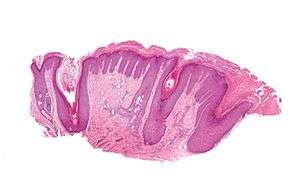Lichen simplex chronicus
Lichen simplex chronicus (LSC) (also known as neurodermatitis[1]) is a skin disorder characterized by chronic itching and scratching.[2] The constant scratching causes thick, leathery, darkened, (lichenified) skin. This condition is associated with many factors, including the scratch-itch cycle, psychological stressors, and atopy. LSC is more common between ages 35 and 50 and is seen approximately twice as often in women compared to men.[3]
| Lichen simplex chronicus | |
|---|---|
 | |
| Micrograph of lichen simplex chronicus. H&E stain. | |
| Specialty | Dermatology |
Signs and symptoms
People burdened with LSC report pruritus, followed by uncontrollable scratching of the same body region, excessively.[2] Most common sites of LSC are the sides of the neck, the scalp, ankles, vulva, pubis, scrotum, and extensor sides of the forearms.[3] However, due to the stigma associated with chronic scratching, some patients will not admit to chronic rubbing or abrasion. The skin may become thickened and hyperpigmented (lichenified) as a direct result of chronic excoriation.[3] Typically this period of increased scratching is associated with stressors.
Causes
This is a skin disorder characterized by a self-perpetuating scratch-itch cycle:[4]
- It may begin with something that rubs, irritates, or scratches the skin, such as clothing.
- This causes the person to rub or scratch the affected area. Constant scratching causes the skin to thicken.
- The thickened skin itches, causing more scratching, causing more thickening.
- Affected area may spread rapidly through the rest of the body.
Many hypothesize LSC has a psychosomatic origin.[3] Those predisposed to itch as a response to emotional tensions may be more susceptible to the itch-scratch cycle. It may also be associated with nervousness, anxiety, depression, and other psychological disorders.[5][6] Many people with LSC are aware of the scratching they do during the day, but they might not be aware of the scratching they do in their sleep.[2] LSC is also associated with atopy, or atopic dermatitis (eczema) and an increase of histamine levels.[2]
Diagnosis
LSC is typically diagnosed by careful observation and history taking.[3] It is easily recognized (see signs and symptoms, and gallery).[2] Biopsies are sometimes necessary to confirm the diagnosis and differentiate it from other similar appearing lesions.
Treatment
Treatment is aimed at reducing itching and minimizing existing lesions because rubbing and scratching exacerbate LSC. The itching and inflammation may be treated with a lotion or steroid cream (such as triamcinolone or Betamethasone) applied to the affected area of the skin.[7] Night-time scratching can be reduced with sedatives and antihistamines.[2] Doxepin is often prescribed, as it offers both antihistamine properties and is also effective at reducing the (itch scratch cycle) associated with the obsessive psychosomatic behavioral symptoms.
Gallery
See also
- Pruritus
- List of cutaneous conditions
References
- Rapini, Ronald P.; Bolognia, Jean L.; Jorizzo, Joseph L. (2007). Dermatology: 2-Volume Set. St. Louis: Mosby. ISBN 978-1-4160-2999-1.
- Lynch, Peter J. (2004-01-01). "Lichen simplex chronicus (atopic/neurodermatitis) of the anogenital region". Dermatologic Therapy. 17 (1): 8–19. doi:10.1111/j.1396-0296.2004.04002.x. ISSN 1396-0296. PMID 14756886.
- Lotti, Torello; Buggiani, Gionata; Prignano, Francesca (2008-01-01). "Prurigo nodularis and lichen simplex chronicus". Dermatologic Therapy. 21 (1): 42–46. doi:10.1111/j.1529-8019.2008.00168.x. ISSN 1529-8019. PMID 18318884.
- Lee, Michael R.; Shumack, Stephen (2005-11-01). "Prurigo nodularis: a review". The Australasian Journal of Dermatology. 46 (4): 211–218, quiz 219–220. doi:10.1111/j.1440-0960.2005.00187.x. ISSN 0004-8380. PMID 16197418.
- Konuk, Numan; Koca, Rafet; Atik, Levent; Muhtar, Sennur; Atasoy, Nuray; Bostanci, Bora (2007-05-01). "Psychopathology, depression and dissociative experiences in patients with lichen simplex chronicus". General Hospital Psychiatry. 29 (3): 232–235. doi:10.1016/j.genhosppsych.2007.01.006. ISSN 0163-8343. PMID 17484940.
- Krishnan, Anjeli; Koo, John (2005-07-01). "Psyche, opioids, and itch: therapeutic consequences". Dermatologic Therapy. 18 (4): 314–322. doi:10.1111/j.1529-8019.2005.00038.x. ISSN 1396-0296. PMID 16297003.
- Yosipovitch, Gil; Bernhard, Jeffrey D. (2013-04-25). "Chronic Pruritus". New England Journal of Medicine. 368 (17): 1625–1634. doi:10.1056/NEJMcp1208814. ISSN 0028-4793. PMID 23614588.
External links
| Classification | |
|---|---|
| External resources |



